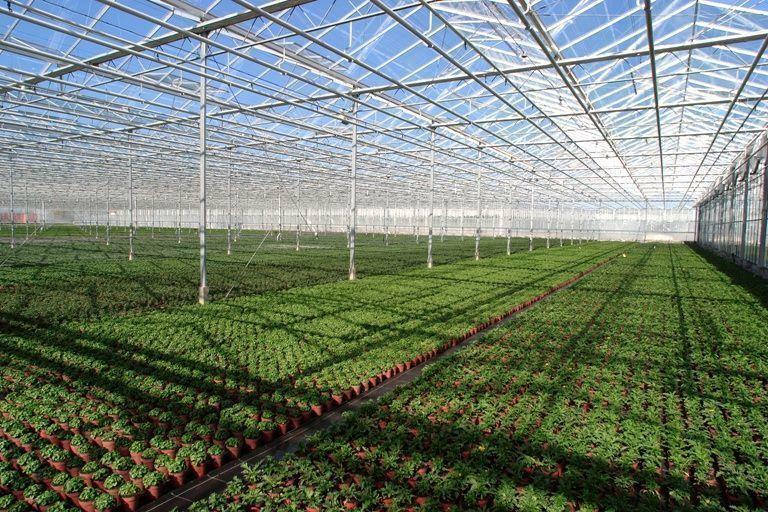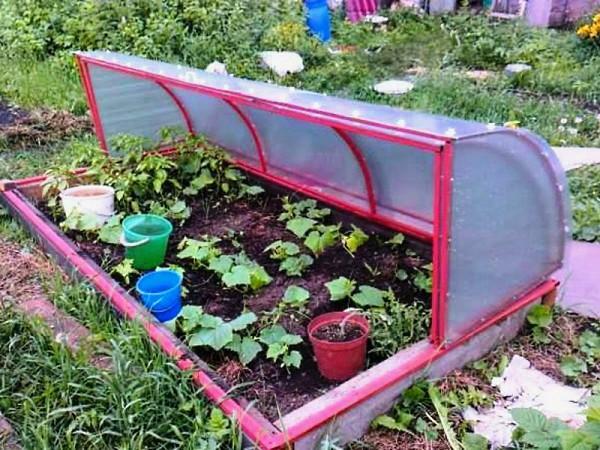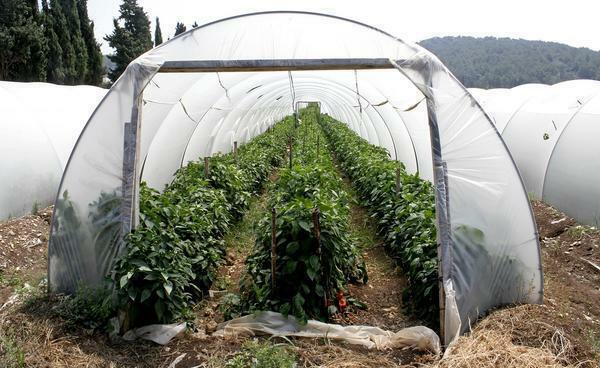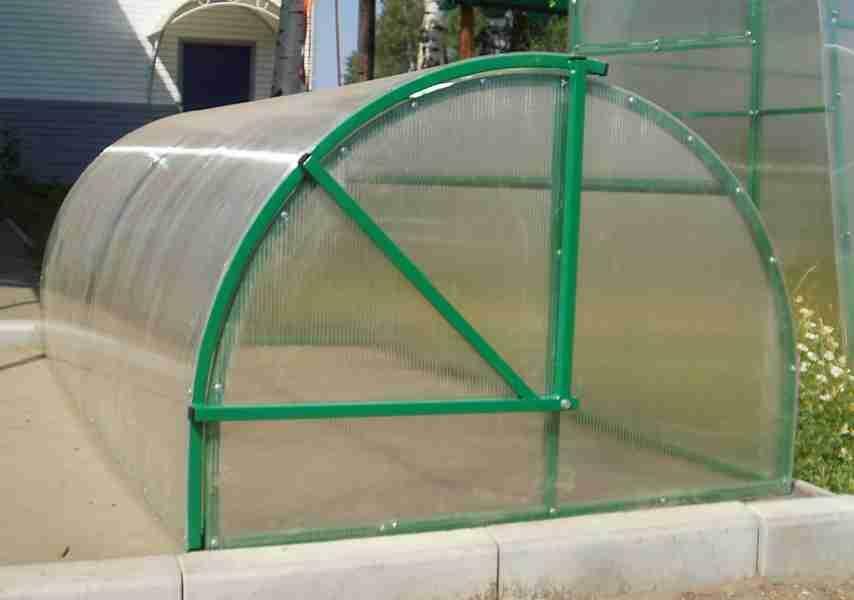 "Snail" greenhouse is used for growing seedlings on different beds A distinctive feature of the "Snail" greenhouse is its compact size and conveniently located flaps. It is suitable for beginner gardeners. Plants are comfortable enough in such a greenhouse, and truck farmers easily take care of crops.
"Snail" greenhouse is used for growing seedlings on different beds A distinctive feature of the "Snail" greenhouse is its compact size and conveniently located flaps. It is suitable for beginner gardeners. Plants are comfortable enough in such a greenhouse, and truck farmers easily take care of crops.
-
- Types of greenhouses: Novator, Butterfly, Snail
- Features of the hotbed-breadbasket "Snail"
- Reviews about the greenhouse "Snail"
- How to assemble the greenhouse "Snail" with your own hands
- Assembling the greenhouse "Snail »(video)
Types of greenhouses: Novator, Butterfly, Snail
The breadbasket has its own peculiarities, but in order to understand how they differ from other species, it is necessary to consider them in detail. The breadbasket has its own name because of the shape, which reminds everyone of the familiar device. It is used for breeding seedlings, harvesting greens or vegetables. The hothouse hothouse is compact and convenient to use, which distinguishes it from other species.
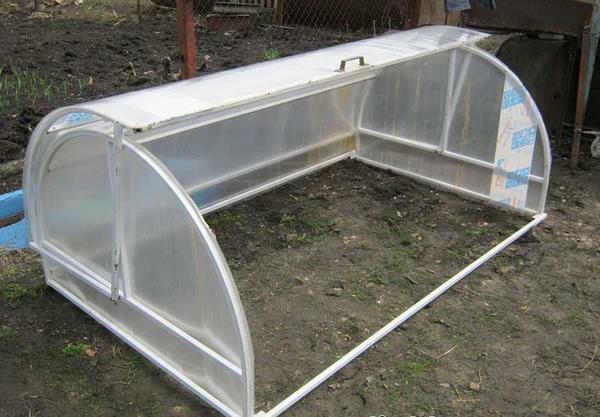 You can make a butterfly "Breadbaker" on your own or buy it ready-made
You can make a butterfly "Breadbaker" on your own or buy it ready-made
Kinds of greenhouses:
- Arched. It has the form of a tunnel. A fairly popular greenhouse through simple installation and use.
- "Butterfly".Opens on both sides, thus reminding the butterfly's wings. Less - it is necessary to additionally equip the supports for the flaps. But it's much more comfortable to look after the crops.
- Unearthly. These include "Innovator", "Butterfly", "Snail" and any other greenhouse that is installed on the ground. Characterized by high mobility.
- In-depth. A distinctive feature of such a hotbed - most of the design is placed in the ground. This creates more heating of plants due to natural factors.
Greenhouses can be different and behind the cover material. You can cover the greenhouse with film, polycarbonate, glass, and also with agrofibre. Polyethylene is the most budget option. But it is not strong at all, it is easily torn. Glass is much stronger. But it is difficult to mount, it is an expensive material that can be installed on a greenhouse with straight lines.
Polycarbonate is the most correct choice. It is durable, flexible and durable. In addition, cellular polycarbonate perfectly retains heat, allows sunlight and protects plants from the negative effects of ultraviolet radiation. Agrofiber is a light, durable material that holds heat well. It is widely used for sheltering beds.
Features of the hotbed-breadbasket "Snail"
Thanks to its design, the "Snail" greenhouse is often called a breadcrumb. The leaf is conveniently opened, similar to the above construction. It is a compact greenhouse that provides comfort to both plants and a gardener who cares for crops.
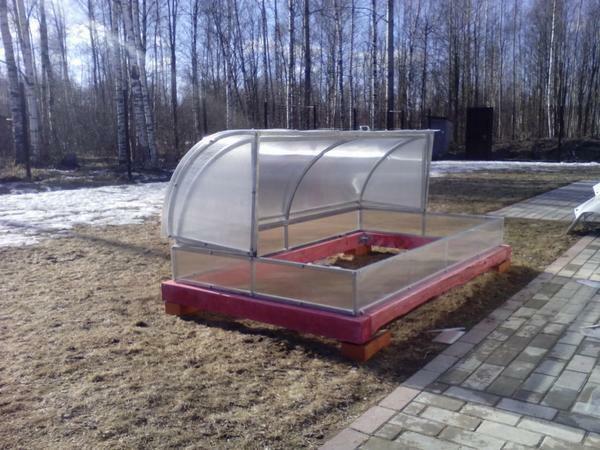 The greenhouse design acquired its name due to the shape and opening method of the leaf, reminiscent of the
The greenhouse design acquired its name due to the shape and opening method of the leaf, reminiscent of the
Advantages of the snail shell "Snails":
- The small size allows mounting it anywhere;
- Mobility of the greenhouse;
- Maximum use of the area, as the entire surface inside is planted with seedlings;
- Ease of operation;
- Resistant to adverse weather conditions( snow, wind) due to low altitude;
- Polycarbonate coating protects crops from UV light;
- Easy to ventilate the greenhouse;
- You can install the installation yourself.
But there is a minus a compact device - it's impossible to grow tall plants in it. Cucumbers or tomatoes do not have the height of the greenhouse for growth. But in such a greenhouse you can grow greens, berries, lettuce, carrots or beets.
The "Snail" bread-making greenhouse can serve as a breeding ground for seedlings. But, for example, tomatoes will eventually have to be transplanted into the open ground or into a greenhouse higher.
The optimum height of the breadbox is only one meter in height. The length of this structure is 2-4 m. The width depends on the number of leaflets. For "Snail enough width of 1.5 m, and for" Butterfly "you need 2 m.
Reviews about the greenhouse "Snail"
The World Wide Web allows you to learn at any time the personal experience of the vegetable growers regarding any kind of greenhouses. On the greenhouse "Snail" there are mostly positive reviews. It is affordable, easy to install and maintain. It is because of this that the greenhouse is so popular.
The snail's greenhouse is lightweight and can be moved around the site every year
The subject of the reviews about the greenhouse "Snail" refers to:
- Compactness. Many write that the model does not take up much space. It can be installed in any free corner of the garden or garden.
- Ease of care. Most of the reviews are aimed at praising the ease of operation of the greenhouse. It is only necessary to open the leaf and access to the plants is. This greatly simplifies watering, ventilation, weed removal and other operations.
- Easy assembly. The greenhouse can be converted to a conventional car, which is very convenient. And the assembly itself will only take a couple of hours. For this, one does not even need to have special skills. The main thing is to follow the instructions.
- Availability. The price of a greenhouse is inexpensive. But this will please the high quality of the design.
- Speed of harvesting. Many boast that you can get the first crops before all neighbors. In the greenhouse, optimal conditions for plant comfort are created, so they grow rapidly.
Negative experience with the use of hotbeds "Snail" practically does not occur. This is a convenient and practical device for growing early greens, berries and some vegetables. Of course, in such a greenhouse is not an option to grow tall plants, but you can cultivate seedlings.
How to assemble a greenhouse "Snail" with your own hands
The installation of a structure always involves preparatory work. It is necessary to take care of the arrangement of the area where the future greenhouse will be installed. It is important to take into account many nuances.
 To install the "Snail" greenhouse construction with your own hands, it is necessary to perform some preparatory work, on which the installation will depend and its durability.
To install the "Snail" greenhouse construction with your own hands, it is necessary to perform some preparatory work, on which the installation will depend and its durability.
Preparatory work:
- Correct site selection. It should be well lit, without the presence of tall buildings nearby. The soil itself needs to be chosen evenly.
- You can mount the greenhouse without a foundation. For this purpose, special frame parts are used. But for a better fixation and reliability of the construction it is possible to build a base with wooden blocks or bricks.
- To prepare the soil, you need to excavate a foundation pit 60 cm deep over the whole area.
- Next, manure or compost should be added. This will provide additional heating of plants.
- Next, you need to top up the soil and conduct abundant watering. To better warm the beds, from above it is necessary to lay the ground with a black film.
You can build the assemblage of the greenhouse "Snail" yourself. It does not require special knowledge or special tools. It is necessary to store it with a screwdriver and accuracy.
The skeleton is first installed. It is mounted on the basis of wood or brick. Next you need to collect the arcs. They are attached using special jumpers. The next step is the fixing of polycarbonate sheets. It is important to choose the right side for fixing the sheets, since the UV protection must be on the outside.
There are several ways to glue polycarbonate. The most optimal method is the use of self-tapping screws and thermowells.
All polycarbonate fixing joints must be treated with sealant. This is a mandatory operation that will ensure the durability and strength of the material. Then you need to fix the sash. In the greenhouse "Snail" they are the pistons on a hydraulic basis.
Assembly of the snail "Snail"( video)
For many gardeners the greenhouse "Snail" is a real find. Its assembly does not require special skills and tools. All operations can be done independently. And care of plants as comfortable as possible.
